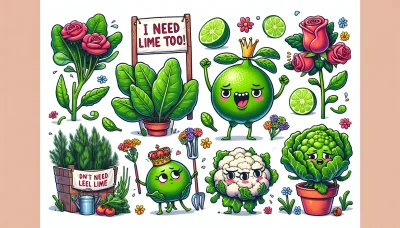How to eat persimmons Quiz
Test Your Knowledge
Question of
How to Eat Persimmons: A Gardener's Guide
Growing persimmons in your own garden brings a unique joy and satisfaction that only gardeners can truly understand. The delight of watching these vibrant, orange fruits develop and ripen under the sun is only matched by the pleasure of tasting their sweet, honey-like flavor directly from the tree. This guide is designed to help you not only grow but also savor persimmons in the most delightful ways, ensuring that your gardening efforts culminate in the most delicious rewards.
Choosing the Right Persimmon Variety
When it comes to persimmons, the variety you choose has a significant impact on how you should consume them. The two main types, Fuyu and Hachiya, have distinct characteristics and uses. Fuyu persimmons are squat and somewhat doughnut-shaped, known for their sweet, crunchy texture that can be enjoyed even when they're not fully ripe. This makes them perfect for eating out of hand, slicing into salads, or adding to cereal. On the other hand, Hachiya persimmons are acorn-shaped and are incredibly astringent if eaten before they're fully ripe. Once they reach a soft, almost jelly-like consistency, their sweetness intensifies, making them ideal for baking or smoothies. Knowing the difference between these two can enhance your culinary experience with persimmons.
When to Harvest Persimmons
Persimmons are a unique and flavorful fruit that require a bit of patience to harvest at just the right time. The key indicators of ripeness in persimmons are their color and texture. As they ripen, persimmons transition from a light yellow-orange to a deep, rich red-orange color. This color change is a reliable sign that they are nearing the perfect stage for eating. In addition to color, the texture of the fruit is a critical clue. Ripe persimmons will feel soft to the touch, similar to a ripe tomato. If the fruit is still hard, it needs more time on the tree to develop its full sweetness and soft texture. Harvesting persimmons at the peak of their ripeness ensures the best flavor and texture for your culinary uses or fresh eating.
Preparing Persimmons for Eating
- Washing: Begin by gently washing the persimmons under cool running water. Use a soft brush or your hands to remove any dirt or debris from the skin.
- Peeling (Optional): For non-astringent persimmons (like Fuyu), peeling is optional since their skin is edible. However, for astringent varieties (like Hachiya), wait until they are fully ripe and soft before peeling, as the skin can be bitter.
- Slicing: Use a sharp knife to slice the persimmons. For Fuyu persimmons, which are firmer and can be eaten like an apple, slice them into wedges or thin slices. For Hachiya persimmons, which are softer when ripe, you can cut them in half and scoop out the flesh with a spoon.
- Eating Astringent Persimmons: Ensure astringent varieties like Hachiya are fully ripe and soft before eating to avoid an unpleasant, puckery taste. They should feel like a water balloon when ripe.
- Eating Non-Astringent Persimmons: Non-astringent persimmons like Fuyu can be eaten while still firm and crisp. They can be enjoyed raw, in salads, or even sliced and added to cereals or desserts.
Creative Ways to Enjoy Persimmons
Persimmons, with their sweet, honey-like flavor, are a versatile fruit that can enhance a variety of dishes. From fresh salads that benefit from their crisp texture to decadent desserts that highlight their natural sweetness, there's no shortage of ways to enjoy this seasonal delight. They also make a fantastic addition to smoothies, offering a rich, smooth texture and a boost of nutrients. Below are some simple recipes and ideas to help you incorporate persimmons into your culinary repertoire.
- Persimmon and Pomegranate Salad - Toss sliced persimmons with pomegranate seeds, mixed greens, and a vinaigrette dressing for a refreshing salad.
- Spiced Persimmon Bread - Incorporate ripe persimmons into your favorite bread recipe, adding spices like cinnamon and nutmeg for a warm, comforting treat.
- Persimmon Smoothie - Blend ripe persimmons with banana, a splash of almond milk, and a hint of vanilla for a creamy, nutritious smoothie.
- Roasted Persimmons - Halve persimmons, drizzle with honey, and sprinkle with cinnamon before roasting until tender. A perfect topping for yogurt or ice cream.
- Persimmon Salsa - Mix diced persimmons with onion, cilantro, lime juice, and jalapeno for a sweet and spicy salsa, great for topping grilled meats or fish.
Storing Persimmons
To extend the shelf life of persimmons and enjoy their unique flavor for as long as possible, proper storage methods are key. For persimmons that are not yet ripe, keep them at room temperature, ideally in a bowl or on a countertop away from direct sunlight. This will allow them to ripen naturally. To speed up the ripening process, you can place the persimmons in a paper bag along with an apple or a banana; the ethylene gas produced by these fruits will help ripen the persimmons more quickly.
Once persimmons are ripe, they should be stored in the refrigerator to slow down the ripening process and preserve their freshness. Place them in the crisper drawer away from vegetables, as fruits can cause vegetables to spoil faster. Ripe persimmons can last in the refrigerator for up to three weeks.
If you have an abundance of persimmons and wish to store them for an extended period, freezing is an excellent option. To freeze persimmons, first wash and peel them. You can then slice the fruit or puree it, depending on how you plan to use it later. If you're freezing slices, lay them on a baking sheet lined with parchment paper and freeze until solid before transferring to a freezer bag; this prevents the slices from sticking together. Pureed persimmons can be poured into ice cube trays or freezer-safe containers. Frozen persimmons are best used within a year and are perfect for smoothies, baking, or cooking.
Benefits of Eating Persimmons
| Nutrient | Benefit |
|---|---|
| Vitamin A | Improves vision and supports immune system |
| Vitamin C | Antioxidant that aids in skin health and immune function |
| Fiber | Helps in digestion and maintaining a healthy weight |
| Manganese | Supports bone health and metabolism |
| Antioxidants | Protects cells from damage and supports heart health |
Incorporating persimmons into one's diet can offer a range of health benefits, from enhancing vision to supporting heart health. Their rich nutritional profile makes them a valuable addition to a healthy eating plan.












